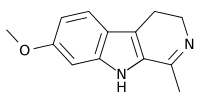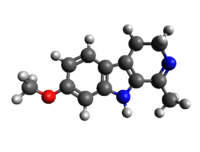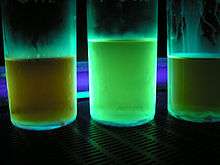Harmaline
Harmaline is a fluorescent indole alkaloid from the group of harmala alkaloids and beta-carbolines. It is the partially hydrogenated form of harmine.
 | |
 | |
| Clinical data | |
|---|---|
| Dependence liability | N/A |
| Routes of administration | Ingestion |
| Legal status | |
| Legal status |
|
| Identifiers | |
| |
| CAS Number | |
| PubChem CID | |
| ChemSpider | |
| UNII | |
| KEGG | |
| ChEBI | |
| ChEMBL | |
| CompTox Dashboard (EPA) | |
| ECHA InfoCard | 100.005.594 |
| Chemical and physical data | |
| Formula | C13H14N2O |
| Molar mass | 214.268 g·mol−1 |
| 3D model (JSmol) | |
| Melting point | 232–234 °C (450–453 °F) |
| |
| |
| | |
Occurrence in nature
Various plants contain harmaline including Peganum harmala (Syrian rue) as well as the hallucinogenic beverage ayahuasca, which is traditionally brewed using Banisteriopsis caapi. Present at 3% by dry weight, the harmala alkaloids may be extracted from the Syrian rue seeds.[1]
Effects
Harmaline is a central nervous system stimulant and a "reversible inhibitor of MAO-A (RIMA)".[2] This means that the risk of a hypertensive crisis, a dangerous high blood pressure crisis from eating tyramine-rich foods such as cheese, is likely lower with harmaline than with irreversible MAOIs such as phenelzine.
The harmala alkaloids are psychoactive in humans.[1] Harmaline is shown to act as an acetylcholinesterase inhibitor.[3] Harmaline also stimulates striatal dopamine release in rats at very high dose levels.[4] Since harmaline is a reversible inhibitor of monoamine oxidase A, it could, in theory, induce both serotonin syndrome and hypertensive crises in combination with tyramine, serotonergics, catecholaminergics drugs or prodrugs. Harmaline containing plants and tryptamine containing plants are used in ayahuasca brews. The inhibitory effects on monoamine oxidase allows dimethyltryptamine (DMT), the psychoactively prominent chemical in the mixture, to bypass the extensive first-pass metabolism it undergoes upon ingestion; allowing a psychologically active quantity of the chemical to exist in the brain for a perceivable period of time.[5] Harmaline forces the anabolic metabolism of serotonin into normelatonin or n-acetylserotonin, and then to melatonin, the body's principal sleep-regulating hormone and a powerful antioxidant.
United States Patent Number 5591738 describes a method for treating various chemical dependencies via the administration of harmaline and or other beta-carbolines.[6]
In a study Harmaline has also been found to induce "vasorelaxant effects" in "isolated rat aorta".[7]
A study has reported the antiviral activity of Harmaline against Herpes Simplex Virus 1 and 2 (HSV-1 and HSV-2) by inhibiting immediate early transcription of the virus at non cytotoxic concentration.[8]
A study found that a single injection of 40 mg/kg in rats or 3 x 25 mg/kg spread over 3 days had visible neurotoxic effects.[9]
Harmaline is known to act as a histamine N-methyltransferase inhibitor.[10] This explains how harmaline elicits its wakefulness-promoting effects.
Legal status
Australia
Harmala alkaloids are considered Schedule 9 prohibited substances under the Poisons Standard (October 2015).[11] A Schedule 9 substance is a substance which may be abused or misused, the manufacture, possession, sale or use of which should be prohibited by law except when required for medical or scientific research, or for analytical, teaching or training purposes with approval of Commonwealth and/or State or Territory Health Authorities.[11]
Canada
Harmaline and Harmalol are considered Schedule III controlled substances by the Controlled Drugs and Substances Act. Every person found to be in possession of a Schedule III drug is guilty of an indictable offence and liable to imprisonment for a term not exceeding three years; or for a first offence, guilty on summary conviction, to a fine not exceeding one thousand dollars or to imprisonment for a term not exceeding six months, or to both. Every person found to be trafficking a Schedule III drug is guilty of an indictable offence and liable to imprisonment for a term not exceeding ten years, or is guilty on summary conviction (first time offenders) and liable to imprisonment for a term not exceeding eighteen months. [12]
See also
- Tetrahydroharmine, a similar harmala alkaloid
- Ibogamine
References
- "Syrian Rue". Erowid.
- Massaro, E. J. (2002). Handbook of Neurotoxicology. Totowa, NJ: Humana Press. p. 237. ISBN 978-0-89603-796-0.
- Zheng XY, Zhang ZJ, Chou GX, Wu T, Cheng XM, Wang CH, Wang ZT (September 2009). "Acetylcholinesterase inhibitive activity-guided isolation of two new alkaloids from seeds of Peganum nigellastrum Bunge by an in vitro TLC- bioautographic assay". Archives of Pharmacal Research. 32 (9): 1245–51. doi:10.1007/s12272-009-1910-x. PMID 19784581. S2CID 1218229.
- Schwarz MJ, Houghton PJ, Rose S, Jenner P, Lees AD (June 2003). "Activities of extract and constituents of Banisteriopsis caapi relevant to parkinsonism". Pharmacology, Biochemistry, and Behavior. 75 (3): 627–33. doi:10.1016/S0091-3057(03)00129-1. PMID 12895680. S2CID 28243440.
- Shen HW, Jiang XL, Winter JC, Yu AM (October 2010). "Psychedelic 5-methoxy-N,N-dimethyltryptamine: metabolism, pharmacokinetics, drug interactions, and pharmacological actions". Current Drug Metabolism. 11 (8): 659–66. doi:10.2174/138920010794233495. PMC 3028383. PMID 20942780.
- US patent 5591738, Howard Lotsof, "Method of Treating Chemical Dependency Using β-Carboline Alkaloids, Derivatives and Salts thereof", issued 1997-01-07
- Berrougui H, Martín-Cordero C, Khalil A, Hmamouchi M, Ettaib A, Marhuenda E, Herrera MD (August 2006). "Vasorelaxant effects of harmine and harmaline extracted from Peganum harmala L. seeds in isolated rat aorta". Pharmacological Research. 54 (2): 150–7. doi:10.1016/j.phrs.2006.04.001. PMID 16750635.
- Bag P, Ojha D, Mukherjee H, Halder UC, Mondal S, Biswas A, Sharon A, Van Kaer L, Chakrabarty S, Das G, Mitra D, Chattopadhyay D (May 2014). "A dihydro-pyrido-indole potently inhibits HSV-1 infection by interfering the viral immediate early transcriptional events". Antiviral Research. 105: 126–134. doi:10.1016/j.antiviral.2014.02.007. PMID 24576908.
- O'Hearn E, Molliver ME (July 1993). "Degeneration of Purkinje cells in parasagittal zones of the cerebellar vermis after treatment with ibogaine or harmaline". Neuroscience. 55 (2): 303–10. doi:10.1016/0306-4522(93)90500-F. PMID 8377927. S2CID 25273690.
- Cumming P, Vincent SR (September 1992). "Inhibition of histamine-N-methyltransferase (HNMT) by fragments of 9-amino-1,2,3,4-tetrahydroacridine (tacrine) and by beta-carbolines". Biochemical Pharmacology. 44 (5): 989–92. doi:10.1016/0006-2952(92)90133-4. PMID 1530666.
- "Poisons Standard October 2015". Australian Government.
- "Controlled Drugs and Substances Act (S.C 1996, c.19)". Justice Laws Website. Retrieved 25 September 2019.
External links
- TIHKAL, #13
- Evans, A. T.; Croft, S. L. (1987). "Antileishmanial Activity of Harmaline and other Tryptamine Derivatives". Phytotherapy Research. 1 (1): 25–27. doi:10.1002/ptr.2650010106.
